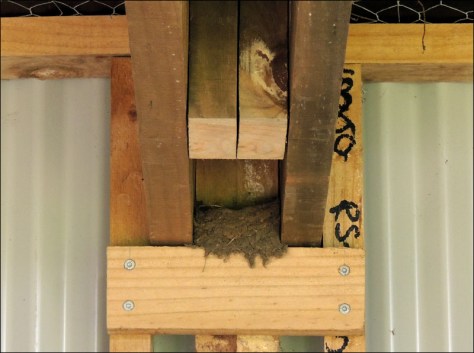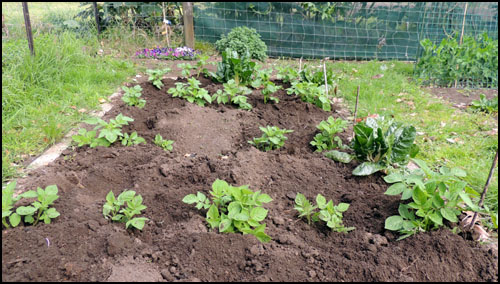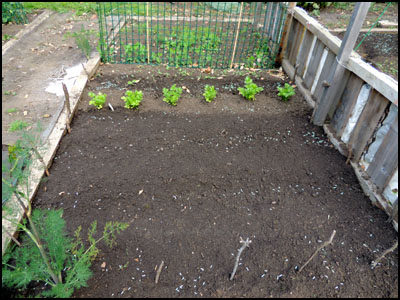Spring is in the air and bursting up through the soil

In the past two weeks the weather has finally turned. It rarely gets very cold in Te Korowai-o-Te-Tonga. For example, we never experience anything close to a frost, but in August and September, after enjoying a number of mild days, we were frequently knocked out of our reverie by a harsh wind change, or days of heavy rain. In fact, there was so little sun from June to September, that I was beginning to feel despondent and to wonder if I’d ever be able to weed my precious flower garden. And yes, we’ve had a spell of rainy weather again, but now when the sun escapes from behind the clouds, it’s hot.
Garden Musings


This has proved to be very successful, to the extent that our new season’s plants (now planted out) are almost at the point of providing us with vegetables—in fact, we picked our first small zucchinis (Zucchini ‘Costata Romanesco‘) only yesterday; babies, I know, but the plants are bursting with flower buds and fruit.

We’ve had lettuces all through winter and there’s a another crop on its way, thanks to a new scattering of seeds. And as per usual practice, we replanted our regular Egyptian Walking onions (Allium proliferum). They are such an amazing onion. Reliable and useful, and I think they look very attractive with their topknots of little bulbils. Along with the garlic, we managed to get these onions into the soil not too long after the shortest day and they are doing really well.
Sweet Onions

And on the topic of onions, when I was in Asahikawa earlier this year, I was fortunate to be invited to a couple of Japanese-style barbecues. One of the vegetables I especially enjoyed was the sweet white onion, sliced thickly and cooked over charcoal. I’d never tried a sweet onion before – I have no idea why, as they are delicious! I was glad to discover that Kings Seeds have two varieties, so I raised a few seeds inside to get them started early, and then sowed seeds outside as well. Many more germinated than I expected, and I’m sure it’s long past the time when I should have separated them all, but it’s a slow task and I’ve only moved a few. I’m hoping for a day next week that’s fine but not too sunny, and I’ll try to get the rest of them sorted out.

The heirloom Spinach ‘Winter Giant‘ seedlings I raised from seed indoors have literally ‘taken off’. Last year I tried out this amazing variety for the first time and was incredibly impressed. Each plant produced a huge head of strong leaves, and yet it was so green, so tender, when steamed. This year we’ve had to protect the plants with netting as the blackbirds also think they’re pretty yummy. We’ve been eating thinnings from our row of Beetroot ‘Detroit Dark Red‘ in our salads, and hidden between the rows of beetroot and spinach is an equally-dense row of the carrot ‘Kuroda Improved‘.
Tomatoes

I’ve raised so many tomato seedlings this year. Most of them the heirloom tomato, ‘Black Krim’, which I have to admit is my favourite tomato. This year I’ve also raised the cherry tomato, Tomato ‘Sugar Plum’, as I wasn’t happy with the variety I grew last year. After battling huge unruly tomato plants over many seasons, we’ve decided that Waratah standard fence posts are the best garden stakes. They are easy to drive into the ground, they never move, they never break and are so strong. Black Krim tomato plants can grow really huge, with many heavy fruit dragging down their stalks. You need something sturdy to avoid catastrophes.
Root Ginger

Home-crystallised ginger is far superior to anything you would buy packaged in a supermarket. And there are a couple of useful byproducts. (1) ginger syrup – you can guess what that’s good for, and (2) you can also consume the water that the ginger was originally simmered in. Ginger, of course, has many health-enhancing properties.
The Birds and the Bees

This Spring we’ve had terrible problems with Kotare flying into one of our bedroom windows. There’s been a pair that likes to sit on the washing line. And when they fly off, they see the trees reflected in the window and fly in a bee-line for it. Bang! So far this year we haven’t had any birds that have knocked themselves out, but it feels like it’s only a matter of time. The photo above shows that we’ve tied some cloths to the line, hoping that the flapping (when it’s windy) will deter the birds, but that hasn’t really worked. We’ve also put masking tape across the window, and so far, this seems to have helped. Fingers crossed.

A pair of Warou, or Welcome Swallows ((Hirundo neoxena), have once again built a nest in the barn – this time it’s the new barn. The photo shows the second nest they built. For some reason they didn’t lay any eggs in the first one, but we peeped into this one with a camera a couple of weeks back and saw four eggs. We don’t wish to go too close now, as the parent birds are sitting, and they get annoyed if we hang around. Sometimes you can see an adult head peeping out from above the nest.

We recently removed the varroa strips from our two hives and I also took the opportunity to check for AFB (American Foul Brood). This involves shaking the bees off all the brood frames, and scrutinising the brood cells. The bees looked healthy and we spotted the lovely Carniolan queen in Hive 01. They’ll be glad to have the honey boxes on top now, as there are many trees and plants in flower at the moment. We were disturbed to discover a herd of tiger slugs slithering up one of the inner walls of hive 03. And Hive 01 looked particularly damp on one edge and had an extended family of woodlice that we had to brush out.
Flower Garden

The flower garden is still going strong, but has been somewhat neglected. Mostly because of the inclement weather in winter which meant I couldn’t get out to knock back the weeds in the way I’d liked to have. There are many plants in flower as I write, but most are from last year, or are Aquilegia, Dianthus, Lavenders, Viola, etc., that have self-sown.
I removed all the lovely dahlias we grew from seed a year ago, and have only recently replanted the tubers around the place. This year I grew a different dahlia from seed, and I’m really looking forward to see what colours I end up with. Growing flowers from seed, in particular, is very rewarding, I think. Especially the varieties that could be anything from a range of colours.

Finally, I have to include a photo of our Amaryllis ‘Apple Blossom’. This plant is so beautiful. And she’s tall as well, nearly up to my waist, definitely up to my hips.
Happy Gardening!
“In the Spring, I have counted 136 different kinds of weather inside of 24 hours.” (Mark Twain)











